| Author |
Message |
La Forge
Bajoran Colonel

Joined: 16 Feb 2006
Posts: 2125
Location: Babylon 5
|
 Mon May 22, 2006 6:37 pm Lock Lock Lock Lock Lock Lock Lock Mon May 22, 2006 6:37 pm Lock Lock Lock Lock Lock Lock Lock |
|
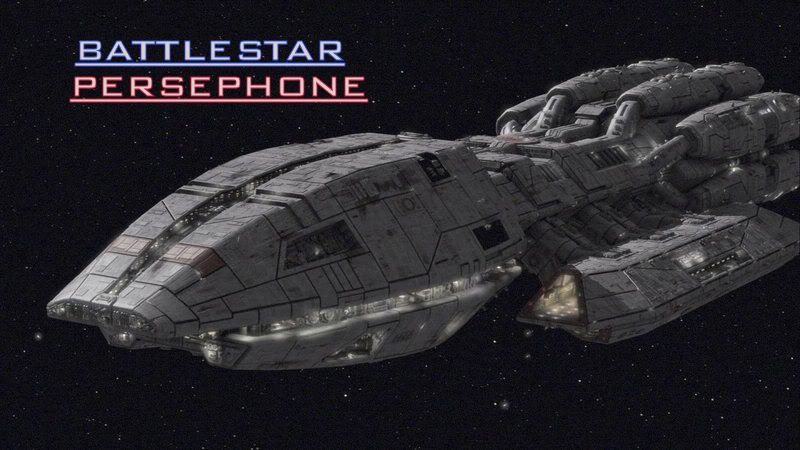
PLOT OVERVIEW
(Battlestar Persephone takes place during the time period of BSG Season One)
Forty years after the Cylon Wars, humanity's deadliest enemies have reemerged with a vengeance. In a sudden, devastating nuclear attack, the Cylon robots - who have now taken human form - wipe out billions of people of the Twelve Colonies. Only a handful of Colonial forces are left to shepherd the few survivors to safety. Commander William Adama, supposedly, the highest-ranking military officer left alive, reactivates the Battlestar Galactica, to once again face humanity's greatest menace.
Outnumbered and outarmed, Adama reluctantly concedes that the newly sworn-in President Roslin is correct - this battle was lost before it had begun. With no choice but to flee, the raging fleet of survivors and humanity's only hope set out in search of the mythic 13th Colony of Kobol...a legendary planet known as Earth.
However, while the Battlestar Galactica is off in search of Earth, two other Battlestars remain. The Battlestars Pegasus and Persephone. While the Battlestar Pegasus goes off after the Galactica, the Battlestar Persephone goes its own way. With half of the crew dead aboard the Persephone, after a devastating Cylon attack, the Persephone is weak. It slowly makes its way across the galaxy, running from the Cylons to the Gods know where. The only thing that keeps the crew of the Persephone together are rumors of other survivors, and, the rumors of the legendary planet of Earth...
With the Cylons on their tail, the crew of the Battlestar Persephone must make their way across the galaxy, alone, in search of other survivors and of a mysterious planet known as Earth...
BATTLESTAR PERSEPHONE
Last edited by La Forge on Fri May 26, 2006 11:08 pm; edited 1 time in total
-------signature-------
You'll never hear me say this again in my life, but...
Go Red Sox!
|
|
|
La Forge
Bajoran Colonel

Joined: 16 Feb 2006
Posts: 2125
Location: Babylon 5
|
 Mon May 22, 2006 6:46 pm Mon May 22, 2006 6:46 pm |
|
BATTLESTAR PERSEPHONE
TECHNICAL SPECIFICATIONS
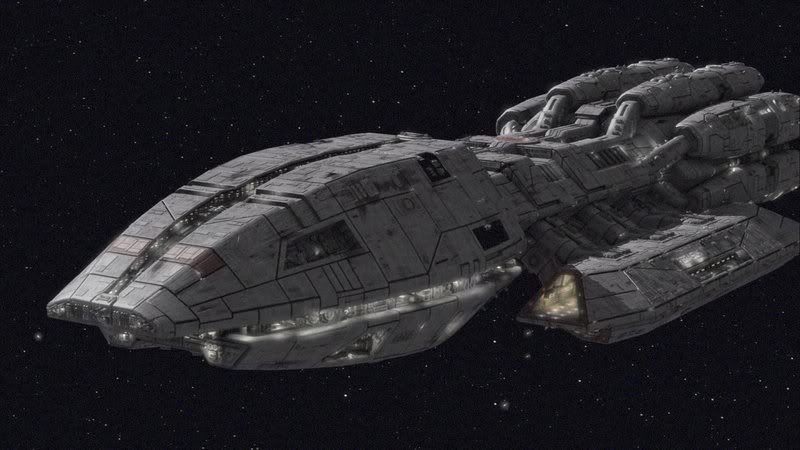
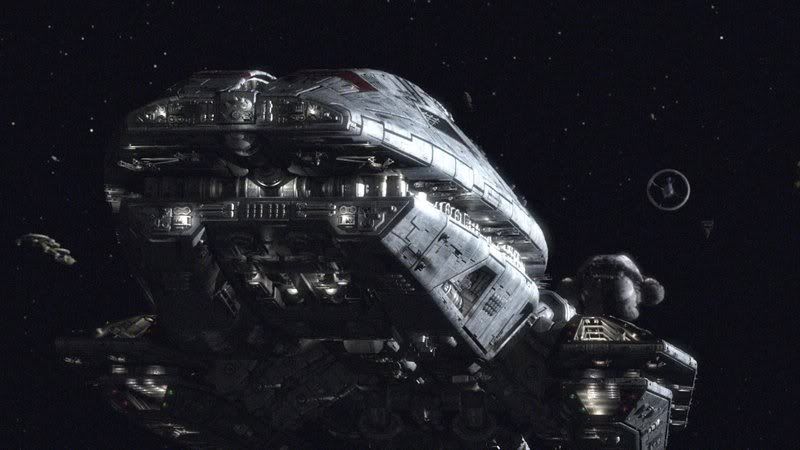
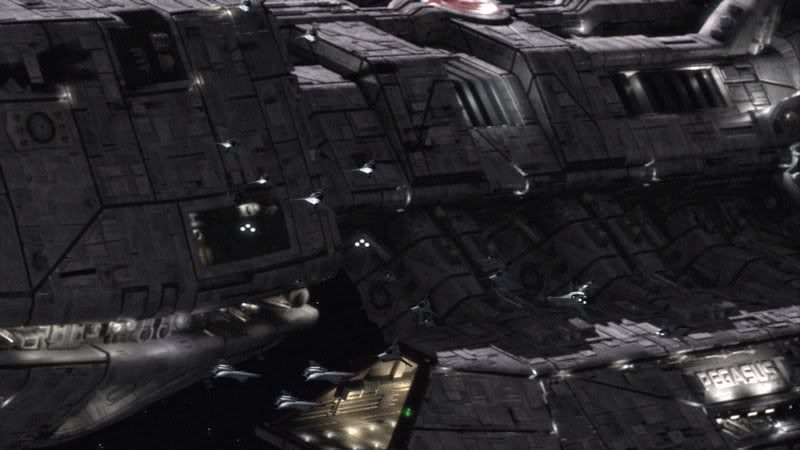
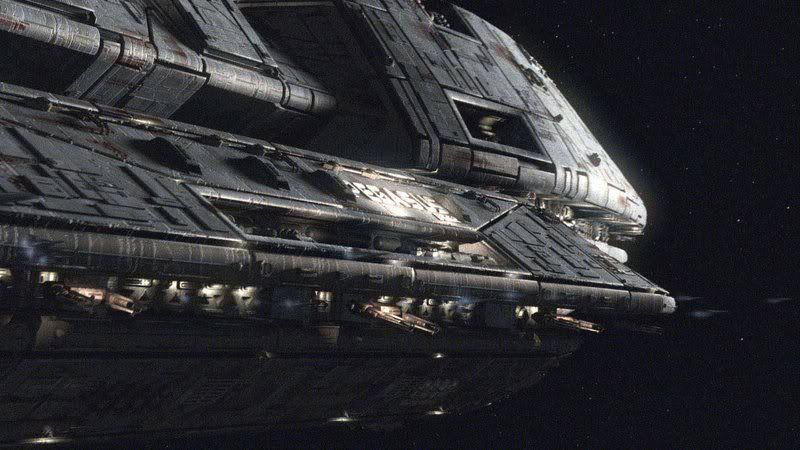
Name: Battlestar Persephone
Class: Mecury-class Battlestar
Race: Colonial
Type: Military
FTL: Yes
Crew: 2,450
CO: ********
XO: ********
Role: Carrier / battleship hybrid
Weapons: Primary and point-defense Kinetic Energy Weapons, conventional missiles, nuclear warheads, Vipers, Raptors
Status: Active
Following the end of the Cylon War, the original battlestars remained in service as other battlestars were built. Their numbers steadily increased to a grand total of 120 ships in the Colonial Fleet. New models employed technologies, such as networked computers, which had been prohibited during the war. A Mercury class battlestar therefore sports several features not found aboard Galactica such as automated sliding doorways and basic computer recognition stations at vital areas. At the time of the Fall of the Twelve Colonies, a Mercury class battlestar was a top-of-the-line craft.
The physical appearance of the Mercury class is different than that of the original battlestar. The "neck" section is smaller, and the Mercury class is equipped with eight sublight engine pods, compared the older class's four. These are also more "boxy" in appearance than those of the original. The flight pods also appear to have two entrances each, above and below the mid-line. Combined with computer assisted landing, this gives the Mercury class a faster rate of Viper recovery than Galactica. Unlike Galactica, Pegasus appears to have a full armor "skin", but in Galactica's case this may have been deliberately removed prior to its scheduled decommissioning.
The gun batteries on the Mercury class are arranged very differently from Galactica's. Where as Galactica's large guns are clustered along her top side, with secondary batteries concentrated along the flight pods, the guns of the Mercury class are found all over the ship. The greatest concentration of large turrets are found along the side of the ship, within the valley created by the upper and lower halves of the hull, including the flight pods. Four are mounted on the underside of the upper hull on the ship's bow, below which sits four non-turreted large guns; these form the main forward batteries. Two more turrets are mounted on the front and back of each flight pod. The Mercury class's secondary guns are distributed all over the ship and do not clearly emerge from the hull like Galactica's.
The Mercury class battlestar is an advanced warship introduced into the Colonial Fleet sometime after the First Cylon War.
The standard crew complement of a Mercury class battlestar is in excess of 2,500.
In addition to having better armament and weapons than Galactica, the Mercury class battlestar has production facilities to build new Viper Mark VIIs from basic resources.
Unlike Galactica, which must retract her flight pods to execute a Jump, the Mercury class battlestar's flight pods appear fixed in place and do not retract during a Jump.
VIPER (Mark II)
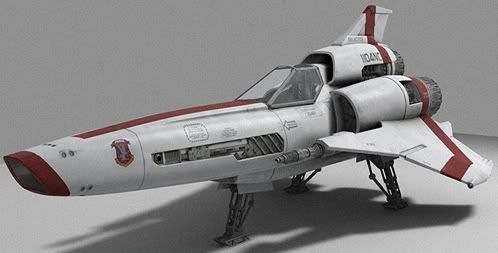
Name: Viper - Mark II
Race: Colonial
Type: Military
FTL: No
Crew: 1 pilot
Role: Space superiority fighter
Weapons: 2 Kinetic Energy Weapons, missiles
Status: Obsolete
Dimensions
Length: 8.4082 meters
Height: 2.7247 meters
Wingspan: 4.7168 meters
VIPER (MARK VII)
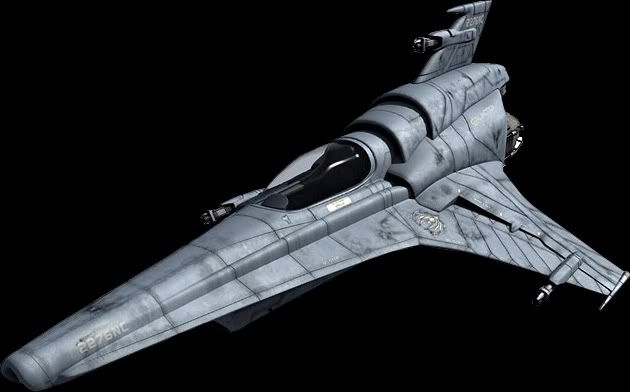
Name: Viper - Mark VII
Race: Colonial
Type: Military
FTL: No
Crew: 1 pilot
Role: Space superiority fighter
Weapons: 3 Kinetic Energy Weapons, missiles
Status: In current Colonial service
Dimensions
Length: 9.8643 meters
Height: 2.9508 meters
Wingspan: 5.61 meters
Following the end of the Cylon War, the original battlestars remained in service as other battlestars were built. Their numbers steadily increased to a grand total of 120 ships in the Colonial Fleet. New models employed technologies, such as networked computers, which had been prohibited during the war. A Mercury class battlestar therefore sports several features not found aboard Galactica such as automated sliding doorways and basic computer recognition stations at vital areas. At the time of the Fall of the Twelve Colonies, a Mercury class battlestar was a top-of-the-line craft.
The physical appearance of the Mercury class is different than that of the original battlestar. The "neck" section is smaller, and the Mercury class is equipped with eight sublight engine pods, compared the older class's four. These are also more "boxy" in appearance than those of the original. The flight pods also appear to have two entrances each, above and below the mid-line. Combined with computer assisted landing, this gives the Mercury class a faster rate of Viper recovery than Galactica. Unlike Galactica, Pegasus appears to have a full armor "skin", but in Galactica's case this may have been deliberately removed prior to its scheduled decommissioning.
The gun batteries on the Mercury class are arranged very differently from Galactica's. Where as Galactica's large guns are clustered along her top side, with secondary batteries concentrated along the flight pods, the guns of the Mercury class are found all over the ship. The greatest concentration of large turrets are found along the side of the ship, within the valley created by the upper and lower halves of the hull, including the flight pods. Four are mounted on the underside of the upper hull on the ship's bow, below which sits four non-turreted large guns; these form the main forward batteries. Two more turrets are mounted on the front and back of each flight pod. The Mercury class's secondary guns are distributed all over the ship and do not clearly emerge from the hull like Galactica's.
Ironically, it was the incorporation of the new integrated systems that prevented the majority of Mark VIIs from being effective during the Cylon attack: as with the majority of Colonial Fleet, the Mark VII suffer fatal computer system failures on contact with Cylon forces. Thanks to a Cylon agent's relationship with Dr. Gaius Baltar, scientist and programmer of the navigation software project, the navigational software in use onboard the majority of Colonial Fleet vessels contained backdoors that allow the Cylons to infiltrate a vessel's network by wireless signals and disable its power systems. While the problem could be overcome by removing the navigational upgrade compromised by the Cylons, this information is not discovered in time to be of major benefit to the surprised and hard-pressed Colonial forces.
Atmospheric Operations
The Viper is designed for atmospheric as well as space-based operations. However, Vipers consume more fuel during atmospheric operations than in the vacuum of space: once in an atmosphere, the engines must run continuously to retain airflow over the wing lifting surfaces. Depending on the composition of the atmosphere itself, this can place severe strain on the Viper's engines.
Due to their wing configuration, Vipers may also suffer from poor handling at low speeds within an atmosphere.
Life Support
Viper cockpits are pressurised and heated, but they are flown with the pilot wearing a flight suit that is capable of providing full life support should ejection be required. The life support systems are built-in to the back of the pilot's seat itself, together with the flight harness. Following an ejection, the back of the seat separates automatically, effectively becoming a backpack for the pilot.
Should ejection take place within an atmosphere, the life support backpack / seat back also incorporates a parachute.
Technical Specifications
Propulsion
Mark II: 1x Voram VM2-D15 upper turbothrust engine, 2x Voram VM3-D22 turbothrust engines; 2x reverse thrust motors; RCS points
Mark VII: 3x turbothrust engines mounted aft; RCS points; angular exhaust nozzle design suggest possible thrust-vectoring.
Armaments
Mark II: 2x MEC-A6 30mm Thraxon forward-firing kinetic energy weapons (KEW) mounted in the wing roots with 800 round magazine; dorsal storage bay for 8x HD-70 Lightning Javelin missiles (optional 50 megaton nuclear warhead)[10]
Mark VII: 3x forward-firing kinetic energy weapons (KEW); 2 mounted towards the outboard sections of the wings; 1 mounted in the vertical stabiliser
Both: Weapon hardpoints for mounting missiles / munitions pods, etc. under the wings; compatible gun ammunition, although Mk VII seems to have a higher rate of fire
Instruments
Mark II: Radio Magnetic Indicator
Mark II: Torque Percent Gauge
Mark II: Attitude Indicator
Mark II: Altimeter
Mark II and VII: Cockpit Avionics
Crew
Pilot in Terrell ES 24C ejection seat.
Performance
Mark II: Can rotate 180 degrees vertically in .35 seconds
RAPTOR
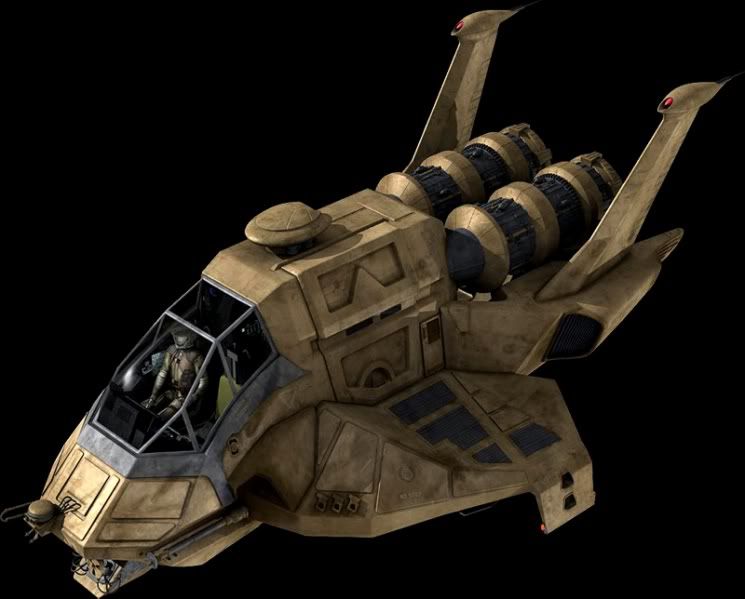
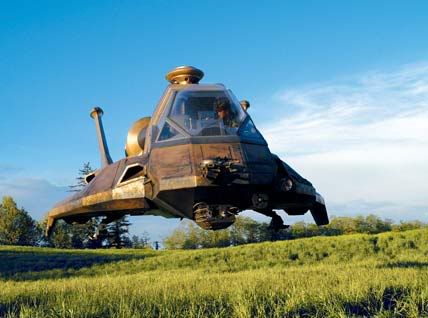
Name: Raptor
Race: Colonial
Type: Military
FTL: Yes (short range)
Crew: 2 (pilot and ECO), approximately 5-10 passengers
Role: Reconnaissance and surveillance, electronic countermeasures support, transport
Weapons: Missiles
Dimensions
Height: 9.5 feet
Weight: 50 tons
Wingspan: 18.34 feet
The Raptor is a multi-role vehicle used by the Colonial Fleet. It is generally operated by a crew of two, is capable of atmospheric flight and is also equipped with a short-range Jump engine, allowing it to make short faster-than-light hops.
The Raptor is designed to fulfill a number of roles, the primary being that of reconnaissance / scout operations. Additionally, the Raptor can also undertake the following roles:
Airborne Warning & Control and Electronic Counter-Measures platform supporting Viper operations
Marine assault carrier
Ambulance / evac vehicle
General purpose transport
As an ECM platform, the Raptor contains a full suite of electronic countermeasure and monitoring tools, enabling it to:
Jam transmissions from other spacecraft
Scramble control signals used by guided weapons
Undertake IFF operations for Viper squadrons
In the role of a scout, the Raptor can operate independently of, or in concert with, other Raptors and Vipers and:
Undertake short and medium-range scans to detect radio, heat or other signatures from other vessels
Scan planetary surfaces for signs of life, energy output, or to assess mineral or other content / location
Scout ahead of its parent warship, scouting star systems, etc., to look for any signs of hostile intent, etc., prior to the parent ship jumping-in
Undertake search & rescue operations.
As a transport vehicle, a Raptor is capable of carrying around 8-10 adults in addition to the 2-person crew. As a marine assault vehicle, it can carry a squad of some eight marines plus their equipment.
Due to its size, the Raptor is not launched via a battlerstar's launch tube; instead it is launched from the forward end of a flight pod.
Typically, a battlestar operates with a single squadron of 8-10 Raptors: 1 Raptor assigned to each operational Viper squadron aboard the battlestar, and potentially two "reserve" Raptors.
Atmospheric Operations
The Raptor is designed for atmospheric as well as space-based operations. However, a critical element to atmospheric operations is that to remain airborne is fuel: once in an atmosphere, the engines must be run constantly to retain lift surfaces. Depending on the composition of the atmosphere itself, this can place severe strain on the Raptor's engines.
Due to their overall configuration and bulk, Raptors may also suffer from poor handling at low speeds, and rely heavily on directed thrust to remain airborne.
FTL Operations
A Raptor seems to be able to make at least 10, and probably at least 20 FTL jumps before refueling. It may, however, have been carrying more than a normal amount of fuel for that mission.
Life Support
The main flight deck / cabin of a Raptor is fully pressurised. However, crews operate in flight suits and helmets to help protect them against any hull breach. The cabin can also be depressurized and used in space rescue operations.
Technical Specifications
Propulsion
2x sublight engines mounted aft
1x small-scale FTL system
RCS points
Armament
Offensive: Normally unarmed as Raptors make for a poor general-purpose fighter. Can be equipped with bombs or rockets/missiles perhaps similar to those used on Vipers
Defensive: Decoy drones, communication drones and flares; reduced electronic signature to avoid detection
Crew
Pilot
ECO
Layout
The Raptor is a boxey vehicle built for purpose, not style. The forward section of the vehicle contains the flight deck, with side-by-side seats for the pilot and ECO (who occupies the rear section of the vehicle during normal operations). This opens into the main body of the vehicle, which contains bulkhead-mounted racks of electronics equipment and sensors. A large canopy provides good forward and side visibility for the crew, which is no doubt of considerable benefit during atmospheric flight. A section of this canopy can be jettisoned in an emergency, to allow the crew to eject using the flight deck seats. A large hydraulic door mounted on the port side of the vehicle provides access to the vehicle. In addition, a floor-mounted hatchway provides a further point of egress. This is linked to a skirt that can be extended from the underside of a Raptor, enabling it to dock with other vessels; in the case of an assault, marines can force an entry into a hostile vessel.
Aft of the pressurised area are the FTL engine and main sublight engines. Winglets on either side of the hull help to give stability during atmospheric manoeuvres and have landing thrusters mounted under them.
-------signature-------
You'll never hear me say this again in my life, but...
Go Red Sox!
|
|
|
La Forge
Bajoran Colonel

Joined: 16 Feb 2006
Posts: 2125
Location: Babylon 5
|
 Mon May 22, 2006 7:26 pm Mon May 22, 2006 7:26 pm |
|
OTHER TECH INFO
RANKING SYSTEM
OFFICERS
Admiral

Commander

Colonel

Major

Captain

Lieutenant

Lieutenant Junior Grade

Ensign

ENLISTED
Master Chief

Chief Petty Officer

Petty Officer

Specialist

Deckhand

Recruit

-------signature-------
You'll never hear me say this again in my life, but...
Go Red Sox!
|
|
|
La Forge
Bajoran Colonel

Joined: 16 Feb 2006
Posts: 2125
Location: Babylon 5
|
 Mon May 22, 2006 7:27 pm Mon May 22, 2006 7:27 pm |
|
RULES
COMING SOON
-------signature-------
You'll never hear me say this again in my life, but...
Go Red Sox!
|
|
|
La Forge
Bajoran Colonel

Joined: 16 Feb 2006
Posts: 2125
Location: Babylon 5
|
 Mon May 22, 2006 7:30 pm Mon May 22, 2006 7:30 pm |
|
RESERVED FOR CHARACTER BIOGRAPHIES
If you have an interest in joining, please send me a PM displaying your interest in doing so. Rules and the character set-up will be put up shortly. Please, in the mean-time, if you would just inform me of your interest in joining Battlestar Persephone while you wait for the above to be put up. Thank you.
-------signature-------
You'll never hear me say this again in my life, but...
Go Red Sox!
|
|
|
|
|
You cannot post new topics in this forum
You cannot reply to topics in this forum
You cannot edit your posts in this forum
You cannot delete your posts in this forum
You cannot vote in polls in this forum
|
Powered by phpBB © 2001, 2002 phpBB Group
Star Trek �, in all its various forms, are trademarks & copyrights of Paramount Pictures
This site has no official connection with Star Trek or Paramount Pictures
Site content/Site design elements owned by Morphy and is meant to only be an archive/Tribute to STV.com
|
























